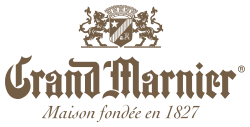Grand Marnier
This article needs additional citations for verification. (February 2011) |
  | |
| Type | Liqueur |
|---|---|
| Manufacturer | Marnier Lapostolle |
| Country of origin | France |
| Introduced | 1880 |
| Alcohol by volume | 40% |
| Proof (US) | 80 US (70 in UK) |
| Colour | bright topaz with gold and amber tints |
| Flavor | Orange |
| Website | www |
Grand Marnier (French pronunciation: [ɡʁɑ̃ maʁnje]) Cordon Rouge is an orange-flavored liqueur created in 1880 by Alexandre Marnier-Lapostolle. It is made from a blend of Cognac brandy, distilled essence of bitter orange, and sugar. Grand Marnier Cordon Rouge is 40% alcohol (70 Proof in UK, 80 Proof in US). Aside from Cordon Rouge, the Grand Marnier line includes other liqueurs, most of which can be consumed "neat" as a cordial or a digestif, and can be used in mixed drinks and desserts. In France this kind of use is the most popular, especially with Crêpes Suzette and "crêpes au Grand Marnier". César Ritz (1850–1918) reportedly came up with the name "Grand Marnier" for Marnier-Lapostolle, who in return helped him purchase and establish the Hotel Ritz Paris.[1]
Varieties
Cordon Rouge
Cordon Rouge or "Red Ribbon" is orange-flavored cognac liqueur and the original Grand Marnier liqueur created in 1880 by Alexandre Marnier-Lapostolle. It is consumed neat and is also used in mixed drinks and desserts.
Awards
- Gold Medal World Spirits Competition, San Francisco 2001
- 4 Star recommendation from F. Paul Pacult’s Kindred Spirits, the Spirit Journal Guide
Signature Series
- No. 1 - Natural Cherry - A blend of Grand Marnier Cordon Rouge with wild tropical Haitian and Dominican oranges and European Griotte cherries.
- No. 2 - Raspberry Peach - A blend of European raspberries and rare red peaches from Ardèche, in the South of France, combined with Grand Marnier Cordon Rouge.
Cordon Jaune
Cordon Jaune or "Yellow Ribbon" Grand Marnier is only sold in some European countries and at some major international airports. Cordon Jaune is a triple-sec Curaçao-like liqueur that is made with neutral grain spirit instead of Cognac. It does not resemble Cordon Rouge or other orange-flavored brandy liqueurs so much as other high-quality, 80 proof triple-sec Curaçao liqueurs, like Cointreau original or Gabriel Boudier Curaçao Triple-sec.
Cuvée du Centenaire
Cuvée du Centenaire ("Centennial Edition"), was first released in limited quantities in 1927 to commemorate the 100th anniversary. It is made with up to 25-year-old fine cognacs and is consumed neat. It is more expensive, at about US$145 per bottle.
Awards
- 5-star recommendation from F. Paul Pacult’s Kindred Spirits, the Spirit Journal Guide
- Double Gold medal at the San Francisco World Spirits Competition 2001
- Gold Medal at the San Francisco World Spirits Competition 2007
Cuvée Spéciale Cent Cinquantenaire
Grand Marnier 150, technically called Cuvée Spéciale Cent Cinquantenaire ("Special Sesquicentennial Edition"), was awarded a Gold Medal at the Salon des Arts Ménagers in 1983 – Brussels, and is the finest type of Grand Marnier. Also Double Gold Medal at the San Francisco World Spirits Competition in 2007. It is made with up to 50-year-old cognacs sealed within hand-finished frosted glass bottles featuring hand-painted Art Nouveau decorations. At approximately $220 USD per bottle, it was previously marketed under the slogan "Hard to find, impossible to pronounce, and prohibitively expensive."[2]
Awards
- “Best of the Best” Spirits in the Robb Report
- 5-star recommendation from F. Paul Pacult’s Kindred Spirits, the Spirit Journal Guide
- “Best Liqueur” at the San Francisco World Spirits Competition 2001
- Double Gold Medal at the San Francisco World Spirits Competition 2007
Cuvée Louis-Alexandre Marnier-Lapostolle
Cuvée Louis-Alexandre Marnier-Lapostolle is a special selection of cognacs taken from the best known districts (Grande Champagne, Petite Champagne, Borderies, Fins Bois and Bons Bois) and aged at length in oak casks. It is only available in duty-free shops in Canada and France and liquor stores in Quebec, Canada and the Netherlands.
Use in food
Grand Marnier is used in several kinds of pastries, such as liquor cream buns. It can also be used in the French Christmas dessert known as Bûche de Noël (Yule log). It is frequently used in recipes for cranberry sauce, as sweetness and citrus can be a contrast to the bitterness of cranberries. It is also an ingredient for the preparation of flambé dishes, such as Crêpes Suzette, Grand Marnier soufflé and crème brûlée. It can also be used in the sauce of the "Canard à l'Orange" roasted duck dish. It can also be simply drizzled over vanilla ice cream.
Mixed drinks
Grand Marnier can be used in mixed drinks. Some examples of these include the Cosmopolitan, Margarita, Sangria, Sidecar, Dirty Harry, Grand Mimosa, B-52, the Grand Marnier Smash, The Grand Smash, The Smash Marnier, The Bloody Smash, The Maced Marnier, The Ace Marnier Smash, Frosty Smash, The Smace, The Grand Hound, The Blood Pug, The Clarke, The Nogley and the Grand Marnier Fireball.
See Also
References
- ^ Michelli, Joseph (13 June 2008). The New Gold Standard: 5 Leadership Principles for Creating a Legendary Customer Experience Courtesy of the Ritz-Carlton Hotel Company. McGraw-Hill Professional. p. 3. ISBN 978-0-07-154833-5. Retrieved 20 May 2011.
- ^ Woollard, Deidre (13 October 2005). ""Grand Marnier Cuvée du Cent Cinquantenaire". Luxist. Retrieved 26 April 2011.
